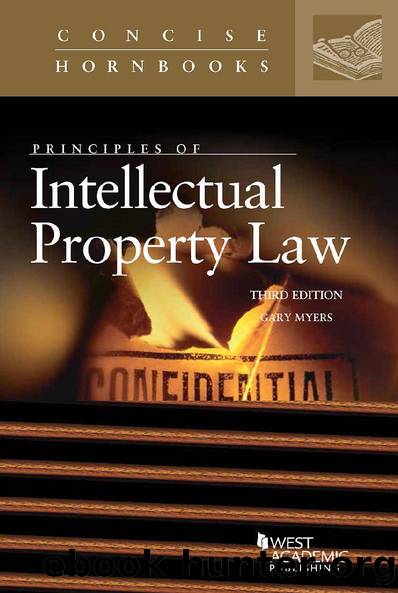Principles of Intellectual Property Law (Concise Hornbook Series) by Gary Myers

Author:Gary Myers [Myers, Gary]
Language: eng
Format: epub
ISBN: 9781634607599
Publisher: West Academic
Published: 2017-01-29T00:00:00+00:00
¶ 7.12CERTIFICATION AND COLLECTIVE MARKS
In addition to the typical trademarks and service marks, there are two other categories of trademarks that are protected under the Lanham Act—certification marks and collective marks. Section 1127 defines a certification mark as a mark “used upon or in connection with the products or services of one or more persons other than the owner of the mark to certify regional or other origin, material, mode of manufacture, quality, accuracy or other characteristics of such goods or services. . . .” Midwest Plastic Fabricators, Inc. v. Underwriters Laboratories, Inc.95 discusses certification marks and the unique concerns associated with this type of mark. It is helpful to become familiar with the distinctions between this type of mark, collective marks, and the typical trademarks and service marks.
Understanding the difference between certification and collective marks can be aided by reviewing some illustrations. Some common examples of certification marks are suggested by J. Thomas McCarthy:
(1)The “Good Housekeeping Seal”—type certification of quality of goods or services. Similar is the Underwriters Laboratories standards and testing type of mark.
(2)The “Roquefort Cheese”—type of certification of regional origin; and
(3)The “Union Label”—type certification that goods were made or services performed by union labor.96
Each of these marks indicate and certify some fact about the products or services that bear the mark. The Good Housekeeping Seal of Approval certifies that the standards of that organization have been met. McCarthy notes that Good Housekeeping claims that eight out of ten buyers surveyed are more likely to purchase a product that bears its seal. The Roquefort certification mark indicates that the cheese has been made using goat’s milk and that it has been aged in caves in the Roquefort region of France.97 Another example of a 254
certification mark is “Certified Angus Beef,” by which the American Angus Association certifies the quality of a type of beef product.
In addition to certification marks, the Lanham Act provides trademark protection for “collective marks,” which are used by members of a cooperative, association, or other collective group to show membership in the group or association. Collective marks indicate that a seller of goods or services is a member of the cooperative or association that owns the mark. Examples cited by McCarthy include an agricultural cooperative, the Sebastian hair salons, and the Professional Golfers Association.98
The distinction between certification marks and collective marks is somewhat unclear. McCarthy notes that “where sellers are a member of an organization with standards of membership, there is a collective trademark, while if there is no membership, but products are certified, there is a certification mark”99 Commentators have noted that some parties might seek to avoid the more rigorous burdens of a certification mark by opting to register a collective mark.100
115 U.S.C. § 1127.
Download
This site does not store any files on its server. We only index and link to content provided by other sites. Please contact the content providers to delete copyright contents if any and email us, we'll remove relevant links or contents immediately.
You Don't Own Me by Orly Lobel(1145)
Hello, My Name is Awesome by Alexandra Watkins(1084)
Intellectual Property Strategy by John Palfrey(1081)
Without Copyrights by Spoo Robert(977)
Democracy of Sound by Alex Sayf Cummings(961)
Profit From Your Idea: How to Make Smart Licensing Deals by Attorney Richard Stim(940)
World War 3.0 by Ken Auletta(903)
A Triumph of Genius: Edwin Land, Polaroid, and the Kodak Patent War by Ronald K. Fierstein(902)
The Trademark Guide by Lee Wilson(893)
Kafka's Last Trial by Benjamin Balint(845)
Data Protection: A Practical Guide to UK and EU Law by Carey Peter(838)
Patent It Yourself: Your Step-by-Step Guide to Filing at the U.S. Patent Office by Pressman David Attorney(822)
What They'll Never Tell You About the Music Business by Peter M. Thall(817)
Mass Media Law by Pember Don & Pember Don(811)
BVR's Guide to Intellectual Property Valuation by Michael Pellegrino(809)
Hello, My Name Is Awesome: How to Create Brand Names That Stick (BK Business) by Alexandra Watkins(809)
The Tech Contracts Handbook: Software Licenses and Technology Services Agreements for Lawyers and Businesspeople by David Tollen(793)
The Copywriter's Handbook by Robert W. Bly(784)
The New Censorship: Inside the Global Battle for Media Freedom by Joel Simon(768)
